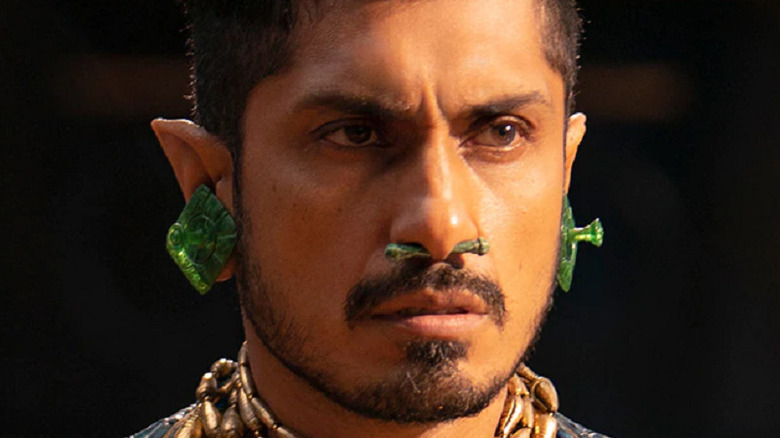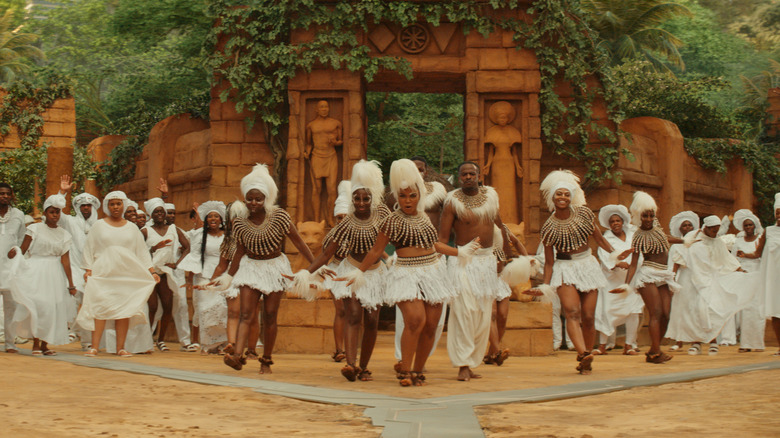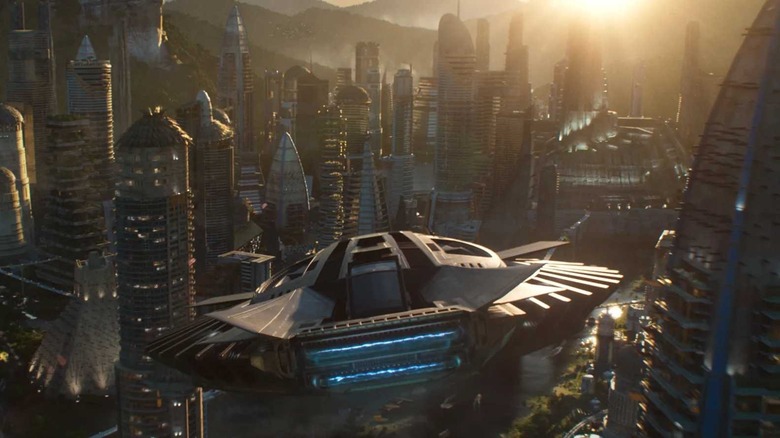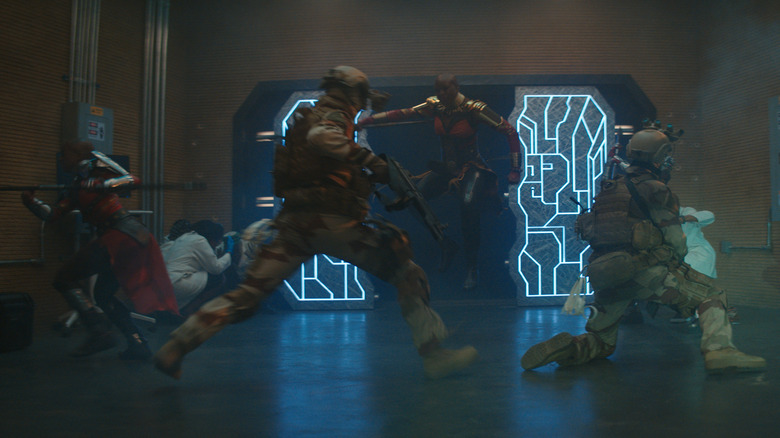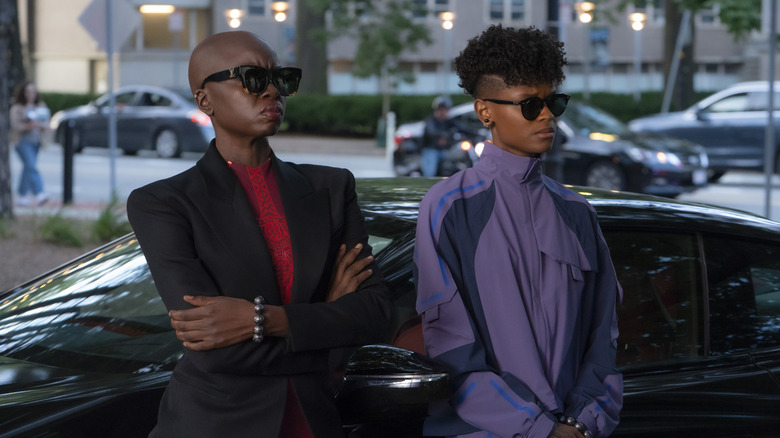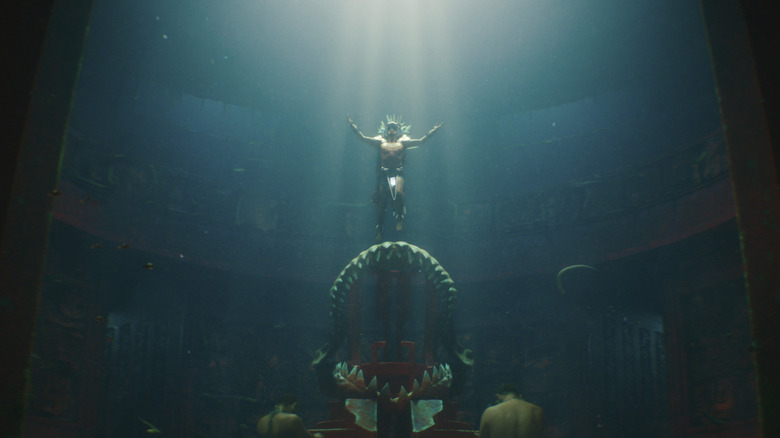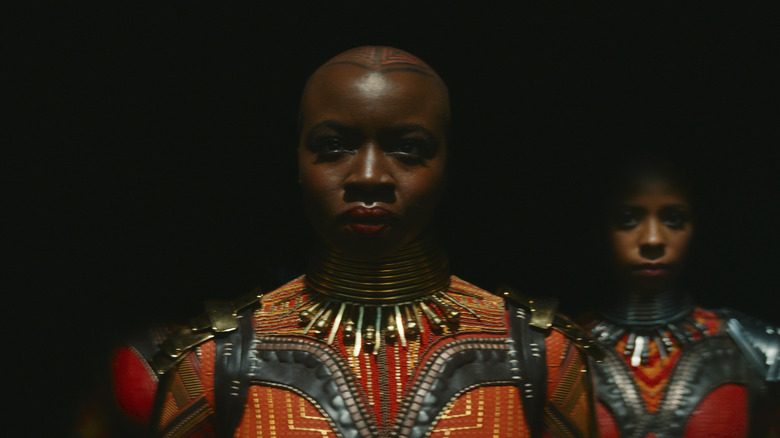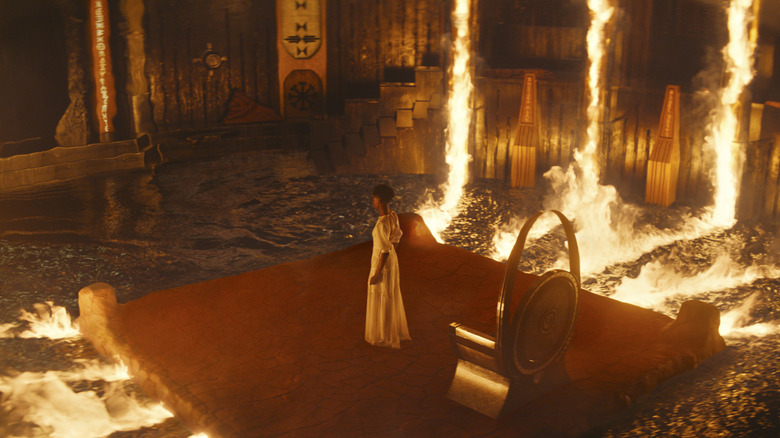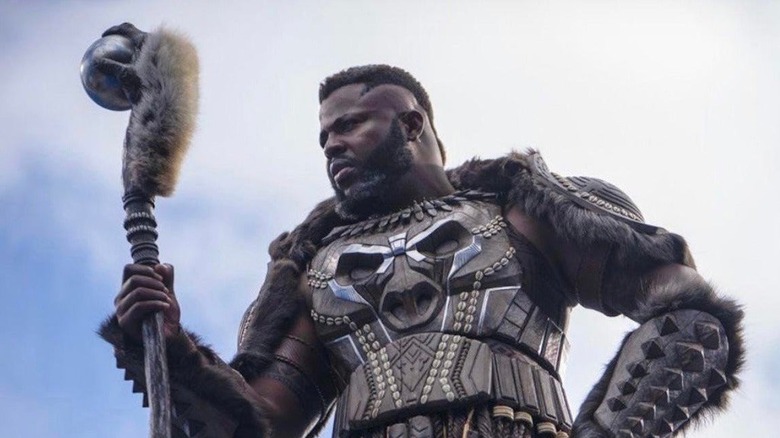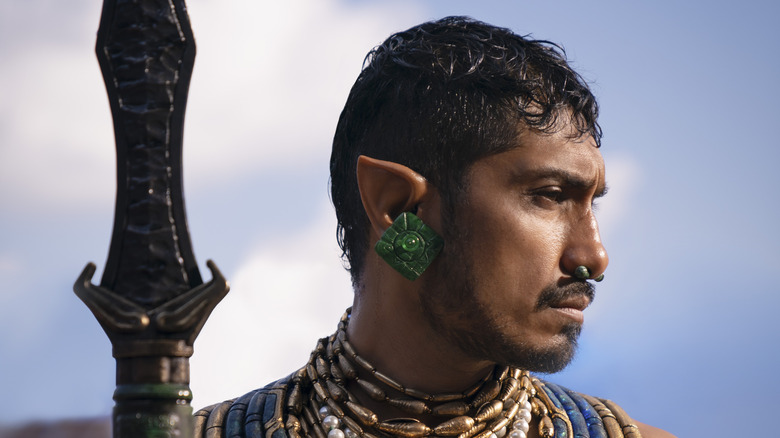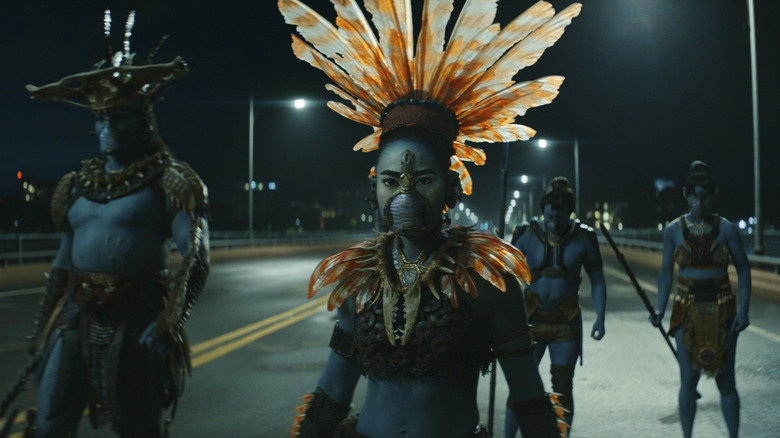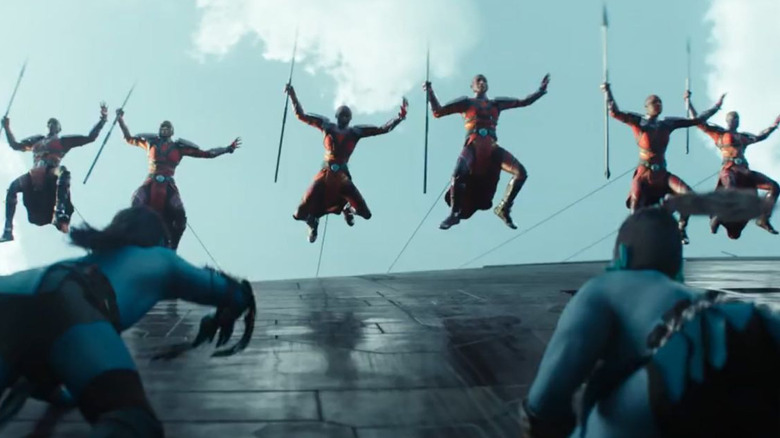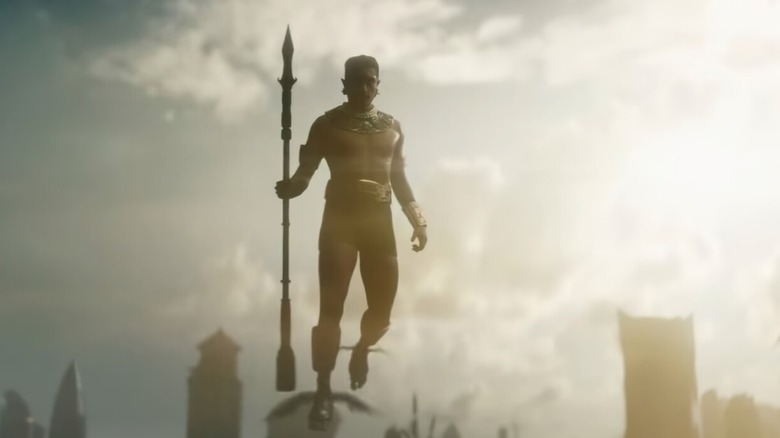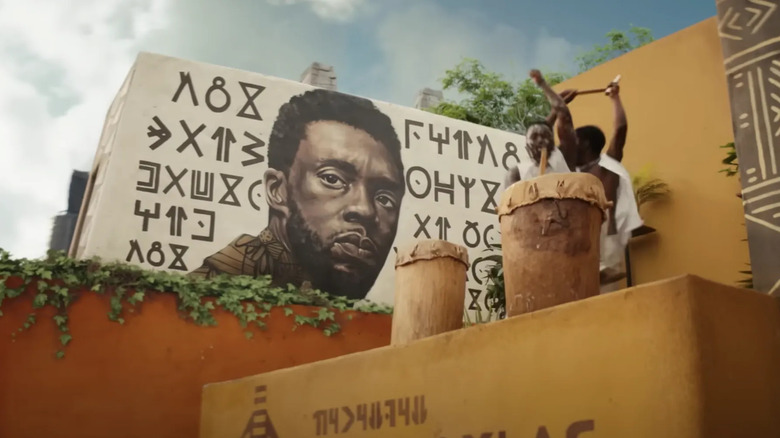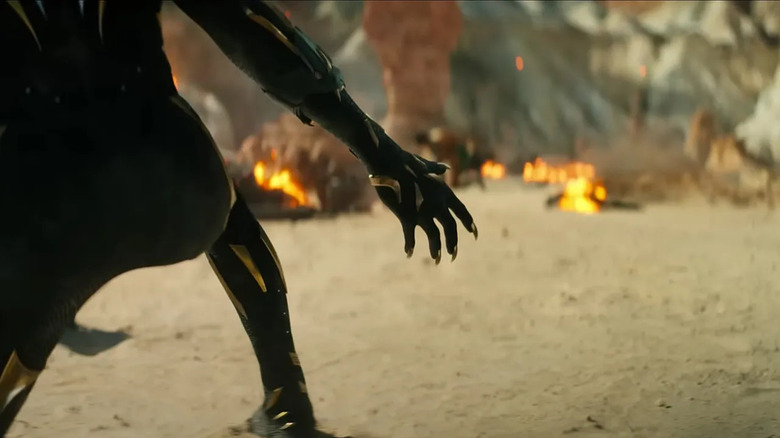Black Panther: Wakanda Forever's 7 Best And 7 Worst Things Ranked
Contains spoilers for "Black Panther: Wakanda Forever"
2018's "Black Panther" ranks among the best of the MCU's 30 feature films and counting in terms of its staggering box office receipts, critical reception, and lasting cultural impact. Its direct sequel was always going to have a lot to live up to, and that was before a pandemic stopped the world (including Hollywood) in its tracks, and its star, Chadwick Boseman, tragically died of cancer. COVID-19 and injuries further delayed production, and fans began to wonder whether a second "Black Panther" movie was even a good idea. But now it's here, and audiences can decide for themselves.
Those who appreciated the first film are likely to have their expectations met by the second one. That shouldn't be a surprise. Ryan Coogler is yet to direct a bad movie, and stories about identity and hardship (as this one is) are right in his wheelhouse. Much of the capable supporting cast of the original "Black Panther" returns, as does much of the behind-the-camera team that made the original so iconic. To sum up why "Black Panther: Wakanda Forever" persevered, talented people who cared about the project put in the time and effort to get it right, and some of them have gotten more skillful at their craft in the past four years.
But that's not to say "Wakanda Forever" reaches the heights of its predecessor. While the film is as cathartic and entertaining as it needs to be and does a lot of things better than it has to (including setting up Phase 5), it's not perfect. And ironically, most of its weak spots have little or nothing to do with the daunting problems its filmmakers faced. These are the best and the worst parts of "Black Panther: Wakanda Forever."
Best: The costume design
2018's "Black Panther" was nominated for seven Academy Awards and won three: Best Original Score, Best Production Design, and Best Costume Design. All three of the creatives responsible for those impressive feats are back in "Wakanda Forever." Composer Ludwig Göransson has returned with even more emotional, heart-thumping music. Hanna Beachler has brought Wakanda (and Boston, Haiti, and Talokan) to life in even more gorgeous detail. But costume designer Ruth E. Carter — who became the first Black woman ever to win the Oscar in the category — has really outdone herself this time.
The costumes in "Wakanda Forever" range from college kid streetwear to high-tech diving suits to ceremonial funeral garb and so much more. Queen Ramonda's (Angela Bassett) many royal ensembles are standouts. In various shades of jewel tones, from form-fitting to billowing, her gowns all still share the same design motif thanks to similar prints and coordinating jewelry. Nakia's (Lupita Nyong'o) bright and casual Haitian teacher clothes suit the character's personality just as much as her vibrant greenish War Dog armor. Namor (Tenoch Huerta) doesn't have much of a costume in terms of quantity, but the quality of the design does much of the work of transforming the character from a comics oddball into a mythical anti-hero god. The outfits are all visually interesting yet believable, and how they pull inspiration from real culture — ancient and modern — is commendable.
Usually, if the camera is going to linger on a particular shot in an MCU film, it's because of fight choreography or expensive CGI. In "Wakanda Forever," the camera frequently lingers on characters just looking awesome in their clothes; Carter's creations are that breathtaking.
Worst: The vehicle design
None of the designs in "Wakanda Forever" are misses, but the fleet of vehicles in the film is probably the weakest element, conceptually. On their own, all the modes of transportation range from fine to pretty cool. The submergible craft that Nakia takes to rescue Shuri (Letitia Wright) and Riri Williams (Dominique Thorne) is innovative. And the ship that arrives to transport T'Challa's vibranium coffin resembles the face of a black panther when it's lit up and viewed from below, which is a nice touch.
But when it actually levitates the casket up in its tractor beam, UFO- or "Star Trek"-style, it takes viewers out of what's an otherwise serious, somber moment. This functionality comes into play a few more times throughout "Wakanda Forever," and each time, it seems a little cheesy compared to the rest of what Wakanda's Afrofuturist technology can do. Some of the other planes that are deployed to evacuate citizens during the flooding of Wakanda look vaguely and curiously like cheaper, simpler versions of Nova Corps starships from "The Guardians of the Galaxy." At one point, Namor describes Shuri as the most powerful being from the most powerful country on the surface world; he thinks her intelligence and technology are so cutting-edge that it's worth forging a truce between their nations, even after everything that's happened in the interim. "Wakanda Forever's" vehicles feel Marvel-y ... they're just not the sleekest and most new-age the MCU has to offer.
Best: The broad politics
Through T'Challa and Killmonger's (Michael B. Jordan) rivalry, "Black Panther" explored political themes such as the merits of isolationism versus interventionism, colonialism, imperialism, and a hypothetical African superpower protected against the exploitative reach of the west. "Wakanda Forever" confronts even heavier and more pressing global issues head-on. The film can be read as a metaphor for nuclear proliferation. The Wakandans possess the world's most powerful resource, and everyone else is in a race to catch up. In the past, real civilizations like Nazi Germany or 1980s Russia have been enemies in Marvel films. This time, it's modern America and France. Being outgunned by a supposed third-world country has exposed the good guys' hypocrisy. Valentina Allegra de Fontaine (Julia Louis-Dreyfus) openly admits she dreams about the U.S. controlling Earth's vibranium supply, but a large chunk of the international intelligence community is willing to resort to some pretty villainous tactics to get what it wants ... that sweet magic metal.
At a United Nations meeting, Queen Ramonda dramatically announces that she's foiled a plot to steal vibranium from one of their secret research facilities by having the Dora Milaje march the captive offenders before their heads of state. She argues it's not vibranium's power she fears, but what humans would do with it. It's a bold move to call out these nations this way, but it works with the story "Wakanda Forever" is trying to tell. The sequel is also interested in colonialism and its effects on indigenous people. In a flashback, we see that Spanish conquistadors brought ruin to Namor's people. His anger at and distrust of the surface world stems from the fallout. Even the film's resolution in which two superpowered beings agree to put vengeance aside and de-escalate their fight plays into the nuclear symbolism. "Wakanda Forever's" politics aren't left or right; they're clear-eyed and practical.
Worst: The vibranium detector plot
Dominque Thorne is a likable addition to the MCU as Riri Williams aka Ironheart, but the plot that introduces her isn't as good as the character herself or Thorne's performance. It's entertaining and gives "Wakanda Forever" some propulsion early on, but it's also a little underbaked.
Through some backchannels that seemingly involve a snitch professor, the CIA, and the military, Riri's school project ends up in the hands of covert operatives who are using it to extract the substance from a sea bed in the Atlantic Ocean. This interference threatens Namor and his people's way of life, so they attack. Problem is, the international community suspects Wakanda was responsible for the defensive strike. Namor wants to team up with Ramonda and Shuri to figure out who invented the vibranium detector so as to protect their kingdoms, since the metal was previously impossible to track. Everything leading up this point is fine if slightly under-explained. What happens next makes less sense.
With Everett Ross's (Martin Freeman) help, Shuri and Okoye (Danai Gurira) track Riri to her dorm room (they don't spill the beans about Namor to Ross, but they're honest with Riri, presumably because he's after her). Later, Namor tells Shuri the girl must die, but why isn't really clear. He doesn't gain anything by killing her. The tech she created is already out there in the world, in the hands of bad actors. The way Shuri bargains with Namor doesn't compute either. She never explains that Riri's merely a college student and that she's so brilliant that she could be an asset to them. Like America Chavez (Xochitl Gomez) before her, Riri is mostly a human MacGuffin.
Best: The switch from Atlantis to Talokan
One of the smartest decisions Ryan Coogler and company made was swapping Marvel Comics' Atlantis for the mythical Mesoamerican city of Talokan (a fictionalization of Tlālōcān, one of the Aztec afterlives). Of course, the decision was more or less made for them since (though Namor came first) the DCEU beat them to the punch with Aquaman, who's basically the half-blood Prince of Atlantis. "Wakanda Forever" changed that bit of Namor's backstory, too. On the page (like Aquaman), he's the son of an Atlantean princess and a human mariner. In the film version, his origin story has everything to do with a vibranium meteorite and Spanish conquistadors. Rooting Namor in Aztec and Mayan history and culture is a vast improvement on an already intriguing comics character, and the Talokan that filmmakers created for him rivals Wakanda.
In 1571, Namor's mother's civilization prays to Tlālōc, the rain diety, for protection from invaders. They drink an elixir of their own vibranium-laced plant, but they mutate into blue beings that can only absorb oxygen from water. Namor was in utero, however, and is born with prolonged life and the ability to breathe air and water, plus he has wings on his feet. This earns him the title K'uk'ulkan or Feathered Serpent God, a supernatural entity pulled from Mesoamerican religion. As a boy, he becomes a legend to his people when he uses his power to fight back against Spanish colonizers. Since the MCU has been interested in geopolitical issues and gods as of late, this updated version of Namor and his home world of Talokan fit right into the cinematic universe's trajectory.
Worst: The way everyone treats Okoye
Danai Gurira's Okoye became one of the breakout characters in "Black Panther" for good reason. The leader of the Dora Milaje was as stoic and tough as anyone in the first film, save for T'Challa himself. Her storyline saw her wrestle with the question of what to do when Killmonger assumed the throne. Okoye was torn between duty to her position and loyalty to her friends. Though Gurira is every bit as captivating in "Wakanda Forever," the film makes her a punching bag and a fall guy. She gets a stunning entrance when the Dora Milaje infiltrate the French operatives planning to steal and study vibranium, but for much of the rest of the movie, she's a joke or MIA.
There's a running gag about how Okoye doesn't like the Midnight Angel armor that Shuri's been developing for her. When she lobbies Ramonda to let her take Shuri on her mission to find Riri, the Princess and the college student make snide remarks about the makeup she's used to cover the tattoos on her shaved head. Shuri also cracks wise about Okoye's age and appearance, implying she can't fit in on a college campus. This might be true, but it all amounts to something that comes crudely close to shaming Okoye for not being feminine, young, or trendy enough. When Shuri and Riri are captured, Ramonda blames Okoye and forces her resignation. Devastated, one of the best characters and best actors in the film is sidelined, all for the heavily foreshadowed Midnight Angel reveal that comes during the final battle.
Best: The use of Killmonger
Michael B. Jordan's Erik Killmonger was such an effective anti-hero in the first film that, after the tragic death of Chadwick Boseman, many fans began to theorize about how the seemingly departed character might return to become the new Black Panther. Killmonger is in "Wakanda Forever," but he doesn't take up T'Challa's mantle. Ryan Coogler uses Jordan sparingly but perfectly.
Remember that Killmonger destroyed the entire crop of heart-shaped herbs in "Black Panther." Since they no longer exist in the wild, there's no mechanism by which to give a Wakandan the power necessary to transform into the nation's protector, nor is there a way for a king or queen to access the ancestral plane. But when Shuri finally cracks the code and produces a synthetic herb with the fibers in Namor's mother's bracelet, she's able to experience the ancient ritual herself.
She expects to see T'Challa, her mother or father, or no one at all (she's a skeptic). Instead, in one of "Wakanda Forever's" strongest scenes, she finds Killmonger on the throne. He's only in the film for a few minutes, but he's deployed effectively as he, with his combative personality still intact, presses Shuri as to how she'll rule. Her cousin is appropriately respectful but still critical of the fallen king, calling him a good man who was too noble. He senses that Shuri is more like him in temperament. She's a doer who isn't stymied by faith or tradition. Their brief interaction is dramatic, visually stunning, and helps put Shuri's emotional journey into perspective.
Worst: The use of M'Baku
M'Baku (Winston Duke) is, sort of like Namor, a character who's sometimes sympathetic and sometimes antagonistic toward the Wakandan royal family. He famously challenges T'Challa in "Black Panther," then comes to his aid when Killmonger takes the throne. Duke makes M'Baku a warm but intimidating presence and one that many fans expected to have a larger role in the sequel after Boseman's untimely real-life death, Killmonger's demise on screen, and Daniel Kaluuya's departure from the franchise. Some fans even wanted M'Baku to become the new Black Panther, despite the fact that the Jabari worship Hanuman, an ape god.
"Wakanda Forever" gives M'Baku some memorable moments. He has a touching heart-to-heart with Shuri that calls back to his insults toward her in the first installment, and he saves the day again when Wakandans are evacuated to his mountains after the flood. But he's largely used as comic relief in a movie that doesn't really need any. Namor easily staves off M'Baku's attack without even turning around to look at him. The Jabari Lord takes a hard hit from the Sub-Mariner that breaks his armor and can't get back up. There's one scene that's so dissonant with the rest of the movie, it's unclear what's supposed to be taking place. When the Wakandans assemble at the edge of the waterfalls to celebrate Shuri's coronation as they once did for T'Challa, it's M'Baku and not the new Black Panther who disembarks from a plane. He says Shuri has more important things to do (she's visiting Nakia to burn her funeral clothes), then he proclaims that he wishes to challenge. It's unclear if this is a joke.
Best: The relationship between Shuri and Namor
In the comics, Namor and Black Panther have a real love-hate relationship. Sometimes they align themselves and their kingdoms with each other for a common cause, and they are both superhuman rulers of super secret societies. But more often than not, they're at each other's throats pledging mutually guaranteed destruction. With the passing of Chadwick Boseman and the decision not to recast T'Challa, somebody new had to put on the Black Panther's mask, not only to wear the costume but to face off against the Sub-Mariner.
Though Boseman and Tenoch Huerta would've been phenomenal scene partners, he and Letitia Wright's Shuri have a totally different chemistry that takes Namor and the Black Panther's love-hate relationship to another level. In this adaptation, there's crackling romantic tension between the mutant god king and the scientist princess. It's never made explicit except for that pretty high-value gift of his beloved mother's bracelet. Still, when Namor offers to take Shuri to Talokan and wistfully confides in her that she's the first surface human ever to have seen their world, it's hard not to imagine them as allies and something more. There's a tragic irony to the idea that these two understand each other but are destined to become enemies, for a time at least. When Ramonda and Nakia invade his home, he retaliates by flooding theirs and indirectly killing many Wakandans, including her mother. Even their final showdown is charged with shared emotion; they're both isolated, angry, and (as Namor's name means in this take on the character) without love. But if only broken people can be great leaders, there are big things ahead for Namor and Shuri, together or apart.
Worst: The underdevelopment of Attuma and Namora
When the MCU took us to Wakanda, viewers got to meet a plethora of new characters including more people of color and more women than the franchise had ever seen before. In addition to T'Challa, his supporting cast of Ramonda, Shuri, Okoye, Nakia, M'Baku, W'Kabi (Daniel Kaluuya), and Zuri (Forest Whitaker) all had unique, fleshed-out personalities of their own. "Wakanda Forever" advertised that audiences would be making the acquaintance of a second superpowered civilization. The trailers and casting news indicated that Attuma and Namora — two important characters from the comics — would be living and fighting alongside Namor (and perhaps against him), just as Okoye and M'Baku did in "Black Panther."
Canonically, Attuma is a barbarian-like Atlantean who believes that he ought to rule instead of Namor, to the point where he's frequently banished and becomes Namor's chief rival. Throughout her comics history, Namora has been everything from Namor's implied lover to his cousin to a clone. She's usually also depicted as a mutant (she and Attuma are two of the Atlanteans with supernatural strength and speed, among other talents). Even with the change from Atlantis to Talokan (and maybe more so because of it), there's enough backstory to have made Attuma (Alex Livinalli) and Namora (Mabel Cadena) more individualized characters. Instead, one of "Wakanda Forever's" few weak spots is the regrettable underdevelopment of its Talokanil supporting cast. They're deployed — much like "Infinity War's" Ebony Maw (Tom Vaughan-Lawlor) and Proxima Midnight (Carrie Coon) — like a henchman and henchwoman who are little more than bodies in the way until it's time for the main characters to fight Namor. We get but a hint that Namora is dissatisfied with Namor and Shuri's peaceful resolution near the end.
Best: The final fight
It's become a refrain that a great many Marvel movies are, well, great ... until the final act devolves into a CGI soup, the main ingredients of which are faceless hoards, Kaiju-like monsters, and of course, sky beams. Though that's a more recent phenomenon, the first "Black Panther" received much criticism for its lackluster last-act digital effects. It seems the filmmakers have learned from their mistakes and from worn-out MCU tropes. The final battle in "Wakanda Forever" is one of Marvel Studios' shorter and smaller-scale scuffles, but in terms of relevance to the plot and visual style, it's a breath of fresh air.
Shuri finally steps into a leadership role as the Black Panther, literally standing at the vanguard of her troops atop a massive military vessel. They're planning to lure Namor to their location so they can trap him in a retrofitted aircraft that will dry him out and deplete his powers. Just as Namor is his people's god of the air, land, and sea, this climactic conflict unfolds in the sky, sand, and on the Atlantic. Riri Williams gleefully buzzes through the clouds in her tricked-out Ironheart suit. Shuri crash-lands on the shore, and the Black Panther and the Feathered Serpent God slash at each other acrobatically in the sand and flames. The Dora Milaje use cables to take on the Talokanil in an impressively choreographed vertical assault, while the Jabari defend the deck. It's all just as ambitious as it needs to be for the story "Wakanda Forever" is trying to tell, which is about how war is rarely in a nation's best interest.
Worst: Namor in fast flight
This might sound like a backhanded compliment, but the MCU's Namor looks way cooler than anyone who's familiar with the comics probably expected. In his earliest illustrated form, the Sub-Mariner looks like a turn-of-the-century muscle man in a belted speedo. And then there's the matter of those pointy elf ears and those little angelic wings that grow out of his feet. Even after Namor got an emo makeover in the '90s, writers and artists still had to contend with those quirks, as did Ryan Coogler in "Wakanda Forever." As per usual, the writer-director was up to the task. Namor is one of the highlights of the movie.
In part, that's thanks to the casting of Tenoch Huerta and his performance, which ranges from endearing to frightening. And in part, that's thanks to the character's new backstory and status as an indigenous Mexican god-king. Namor still has his skimpy green shorts, but the costume has been redesigned with native iconography and materials. Somehow, even the image of the mutant hovering in place — his tiny foot-wings flapping fast — looks pretty rad rather than ridiculous. All of this is an enormous accomplishment, considering how often Namor looks silly in comic books and how serious "Wakanda Forever" is for most of its runtime. The only moments in which it's hard to take the movie and its anti-hero seriously come when the mutant leaps and bounds through set pieces like Legolas doing parkour, or when he uses his winged feet to dash across the sky, not unlike a hummingbird. CGI has come a long way, but it still can't make superhuman feats like that look natural.
Best: The handling of Chadwick Boseman's death
The most impressive thing about "Wakanda Forever" is the way it handles its most daunting obstacle: the death of its lead actor. To that end, the film exceeds expectations and puts to rest the notion that T'Challa should have been recast.
It's respectful and evidence of strong writing that T'Challa dies (not unlike Boseman) from an illness that even the best scientists can't cure. Shuri's developing a synthetic heart-shaped herb to heal her brother, since the real thing is extinct because of Killmonger. Coogler didn't know Boseman was ill when he wove that plot point into the original film, but it ended up being central to the "Wakanda Forever" rewrites. The herb's extinction is also the rationale for why there isn't currently a Black Panther. The multitudinous though often subtle tributes to T'Challa (and by extension, Boseman) keep us grounded in Wakanda's loss and his family's grief.
Then there's that mid-credits scene. Nakia presents her son to Shuri, who has come to Haiti to burn her funeral clothes. She confirms T'Challa is his father and says he prepared them for his passing. The boy, who's also named T'Challa, even got to meet Ramonda before she drowned. As the MCU is in a transition period, with veteran characters on their way out as the younger generation joins in, this is an elegant and heartwarming solution to the problem of who should be the Black Panther going forward. Shuri will have her turn, as will her nephew. After one too many mid- and end-credits stingers that teased far-off projects or made cheap jokes, this lone earnest epilogue is a nice change of pace.
Worst: Shuri's motivation
It was probably the right decision to focus "Wakanda Forever" on Shuri. After all, she is (or was) next in line to the throne after her brother, and she does become Black Panther for an arc in the comics. Letitia Wright had impossibly big shoes to fill; Chadwick Boseman and Michael B. Jordan's performances are regularly cited as helping to make "Black Panther" better than the average superhero movie. Wright's a dynamic screen presence, and she excels at the role she's given. But a character's motivation is what drives an actor's performance, and as written, Shuri's motivations aren't particularly well thought-out.
It was smart to tie her narrative arc to her mourning process for her late brother. It even makes sense that, as clever and capable as she is, she'd feel guilt over not being able to save him. Perhaps she'd even feel anger ... at herself. But the movie doesn't lay the groundwork to make us believe that Shuri would let the world burn (or even set it afire) because of T'Challa's death. No nation is responsible for his illness. It's also not in character for Shuri to have given up on the synthetic heart-shaped herb. Ancient mysticism aside, it's still an application of technology that could help people. Namor's hostility to the surface world is justifiable, but Shuri's rage and reluctance seem like they've been tacked on so the movie can happen.
